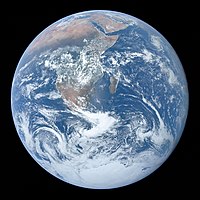
Photo from wikipedia
Abstract This paper presents statistical estimates for the location and duration of habitable zones (HZs) around stars of different mass. The approach is based upon the assumption that Earth's location,… Click to show full abstract
Abstract This paper presents statistical estimates for the location and duration of habitable zones (HZs) around stars of different mass. The approach is based upon the assumption that Earth's location, and the Sun's mass, should not be highly atypical of inhabited planets. The results support climate-model-based estimates for the location of the Sun's HZ except models giving a present-day outer-edge beyond 1.64 AU. The statistical approach also demonstrates that there is a habitability issue for stars smaller than 0.65 solar masses since, otherwise, Earth would be an extremely atypical inhabited world. It is difficult to remove this anomaly using the assumption that poor habitability of planets orbiting low-mass stars results from unfavorable radiation regimes either before, or after, their stars enter the main sequence. However, the anomaly is well explained if poor habitability results from tidal locking of planets in the HZs of small stars. The expected host-star mass for planets with intelligent life then has a 95% confidence range of 0.78 M⊙ < M < 1.04 M⊙, and the range for planets with at least simple life is 0.57 M⊙ < M < 1.64 M⊙. Key Words: Habitability—Habitable zone—Anthropic—Red dwarfs—Initial mass function. Astrobiology 17, 61–77.
Journal Title: Astrobiology
Year Published: 2017
Link to full text (if available)
Share on Social Media: Sign Up to like & get
recommendations!